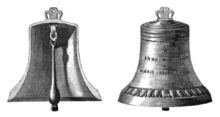Whitechapel Bell Foundry
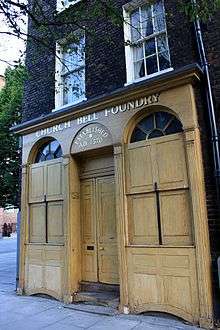
The Whitechapel Bell Foundry is a bell foundry in Whitechapel in the London Borough of Tower Hamlets, and is the oldest manufacturing company in Great Britain.[1] The foundry's main business is the bellfounding and manufacture of church bells and their fittings and accessories, although it also provides single tolling bells, carillon bells and handbells. The foundry is notable for being the original manufacturer of the Liberty Bell, a famous symbol of United States independence, and Big Ben which rings from the north clock tower at the Houses of Parliament in London. The foundry's premises are a Grade II* listed building. The foundry will close in May 2017, after nearly 450 years of bell making and 250 years at its present site.[2] The building is to be sold, and the current owners Alan and Kathryn Hughes are looking to find a buyer for the business which could continue operation at another site.[3]
History
The Whitechapel Bell Foundry company dates back to 1570. The present premises at 32–34 Whitechapel Road, backing on to Plumbers Row, dates from 1670 and was formerly a coaching inn called "The Artichoke" which had been damaged in the Great Fire of London.[4] The Artichoke ceased trading in 1738 and the following year the Whitechapel Bell Foundry moved into the premises. The foundry will remain at the site until May 2017, its future uncertain.[5][2] It is one of only two bell foundries left in the UK and has been in continuous production for almost 450 years.[3] The Master Founders (bell makers) of Aldgate and Whitechapel however can be traced back to 1420. The three bells manufacturer's mark can be seen on the bells and the three bells sign hangs over the door.[6] According to present owners Alan and Kathryn Hughes the foundry has been a family owned company throughout its history continuing when Mr Hughes' grandfather bought the company in 1904.[4]
The business has had to adapt throughout the centuries and in modern times, with new churches being built less frequently, produced handbells, doorbells and even responded to a surge in orders from the USA for table bells following the popularity of the BBC period drama Downton Abbey, with a third of its sales going overseas.[7] In 2013 the foundry launched an online shop selling house bells, musical instruments and other personalised merchandise.[7] The large bell business has been largely unaffected by periods of financial depression partly owing to the fact that from enquiry to completion an order takes on average 11 years.[4] During the second world war the foundry was used as a munitions production line where they made casings for the Ministry of War.[6]
| “ | The government not only guaranteed the orders. They guaranteed good prices and they also guaranteed quick payment, which is something that the Church of England has never managed to do with us. | ” | |
| — Alan Hughes[6] | |||
The foundry was particularly busy after the war replacing bells lost or damaged by fire in bombing raids across London.[8] Hughes said “Our business runs counter to the national economy. If the economy goes down and unemployment rises, we start to get busy. Last year was our busiest in thirty years, an increase of 27% on the previous year. Similarly, the nineteen twenties were very busy." Hughes also tells a story of an order requested of his grandfather in the eighteen nineties which his father quoted again for in the nineteen fifties and he himself gave a quote for in the nineteen seventies. The order was finally completed in 1998.[2]
Notable bells
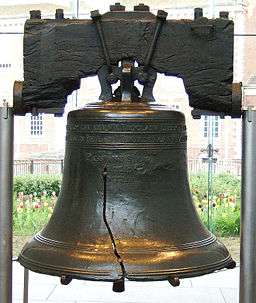
In 1752 the foundry cast the Liberty Bell, which was commissioned to celebrate the 50th anniversary of William Penn's 1701 Charter of Privileges, Pennsylvania's original constitution. As a result of damage sustained during its stormy passage across the Atlantic, the bell cracked in 1846 when it was first rung to mark the birthday of George Washington. Since 2003, the bell has been housed at the Liberty Bell Center near Independence Hall.[5]
Big Ben, which tolls the hour at the Palace of Westminster, was cast in 1858 and rung for the first time on 31 May 1859. "Big Ben" weighs 13½ tons and is the largest bell ever cast at the foundry.[5] This bell also cracked because too heavy a hammer was initially used. The crack and the subsequent retuning gives Big Ben its present distinctive tone. A profile template of Big Ben surrounds the entrance door of the Whitechapel Foundry, while the original moulding gauge is retained near the furnaces.[9] The final bill for Big Ben came to £572.[10]

Whitechapel supplied the peal of 10 bells (later augmented to 12) for Guildford Cathedral in Surrey[11] in the years following the Second World War, recast and augmented the bells of Canterbury Cathedral to a peal of 14 in 1981,[12] and for the National Cathedral in Washington DC in 1962.[13]
The foundry produced "Great Tom" at Lincoln Cathedral,[14] the "Clock Bells" at St Paul's Cathedral, the bells of Westminster Abbey and the 13 bells located at Liverpool's Anglican cathedral which are notable for being the heaviest change-ringing peal of bells in the world, and where the bellfounder Albert Hughes is commemorated in a stained glass window in the nave.[15]
Many churches across the world have bells cast by the Whitechapel Bell Foundry, including: Armenian Church, Chennai; St Dunstan's, Mayfield; St Dunstan's, Stepney; St Mary-le-Bow, Cheapside; St. Michael's Church, Charleston; St Michael's, Beckwithshaw; Church of St Thomas the Apostle, Killinghall; St Stephen's Anglican Church, Newtown and St Philip's Church.[16]
Following the September 11 attacks on the United States in 2001, the company made a tribute bell, the Bell of Hope, as a gift from the people of London to the city of New York.[7] It is rung at 08:46 each year on the anniversary of the tragedy, the time the first plane hit the first tower.[17] It was designed by architect Paul Byard and was rung for the first time on American soil by by the Bishop of New York, the Rt. Rev. Mark S. Sisk. The bell resided at Trinity Church (Manhattan),[18] before being moved to St. Paul's Chapel. In 2005 it was rung again four times for the people killed in the 7 July 2005 London bombings.[19]
The Whitechapel Bell Foundry designed the Olympic Bell seen at the opening ceremony for the London 2012 Olympic Games, although it was not cast on the premises. The furnaces at Whitechapel could not provide the 23 tons of molten metal required to make the bell, so it was manufactured at a factory in the Netherlands which normally produces ship's propellers.[20]
The Foundry also cast the Royal Jubilee Bells used on the lead barge for the Thames Diamond Jubilee Pageant in June 2012,[21] which now hang in the church of St James Garlickhythe. Thomas Mears II cast the bell for Herne Bay Clock Tower in 1837.[22]
Master founders
The names on this list are those that are cast into the surface of Whitechapel bells of different dates. Prior to Robert Mot, in 1574, the sign of three bells was often cast to indicate that it was a Whitechapel (or Aldgate) bell.[23][24]
|
|
-

Bell makers' memorial inside the foundry
-
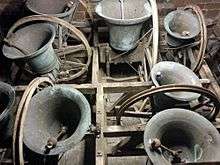
The bells of St Bees Priory shown in the "up" position. Cast by Charles & George Mears in 1857
-
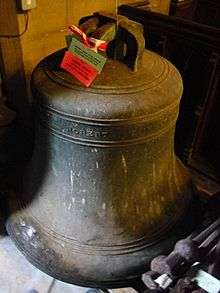
The Robert Stainbank tenor bell from Todmorden Unitarian Church, West Yorkshire, during overhaul in 2014. The bell was cast in 1868.
-

Handbells on the workbench at the foundry
-

Template for Big Ben which hangs at the foundry
-
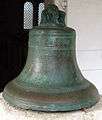
The oldest bell in Barbados, cast at Whitechapel
-

Guildford Cathedral bell cast at Whtechapel
References
- ↑ "500 Years of History" Whitechapel Bell Foundry website, accessed 26 December 2013.
- 1 2 3 The Gentle Author. "So Long, Whitechapel Bell Foundry". Spitalfields Life. Retrieved 2 December 2016.
- 1 2 Farrell, Sean (2 December 2016). "Whitechapel Bell Foundry to ring in new era as owner sells site". Guardian. Retrieved 2 December 2016.
- 1 2 3 Harley, Nicola. "Bell tolls for world's oldest foundry". Telegraph. Retrieved 2 December 2016.
- 1 2 3 Winn, p. 201.
- 1 2 3 Murray Brown, John. "Big Ben and Liberty Bell maker to close London foundry". Financial Times. Retrieved 2 December 2016.
- 1 2 3 Anderson, Elizabeth. "Ringing in the New Year – Britain's oldest manufacturer on five centuries of bell making". Telegraph. Retrieved 2 December 2016.
- ↑ "Bell foundry famous for creating Big Ben to close". Belfast Telegraph. Retrieved 2 December 2016.
- ↑ Whitechapel Bell Foundry The Story of Big Ben accessed 21 May 2007
- ↑ Chaudhuri, Saabira. "Bell Tolls for London's Whitechapel Foundry, Which Made the Liberty Bell and Big Ben". Wall Street Journal. Retrieved 2 December 2016.
- ↑ "Bell Ringing", Guildford Cathedral website, accessed 26 December 2013.
- ↑ "Bells of Canterbury Cathedral", Canterbury Cathedral website, accessed 26 December 2013.
- ↑ Dove's guide.
- ↑ Pickford, Chris. "Great Bells of Britain". Retrieved 3 November 2014.
- ↑ Winn, p. 202.
- ↑ "TOWER OF ST. PHILIPS, CHURCH HILL, SYDNEY.". Construction and Local Government Journal (NSW : 1913 – 1930). NSW: National Library of Australia. 9 February 1927. p. 13. Retrieved 12 December 2013.
- ↑ "Bell of Hope rings for 9/11 attack victims – video". Guardian. Retrieved 2 December 2016.
- ↑ "New York: The 9-11 bell dedication". Whitechapel Bell Foundry. Retrieved 2 December 2016.
- ↑ Colby, Edward B. "9-11 Bell honors London victims". New York Daily News. Retrieved 2 December 2016.
- ↑ "London 2012: Olympic bell made in Holland", The Telegraph (online edition), 20 April 2012, accessed 26 December 2013.
- ↑ "Thank you one and all: the people who helped make the Jubilee happen". Daily Telegraph. 10 June 2012.
- ↑ Bundock, Mike (2000). Herne Bay Clock Tower: A descriptive history. Herne Bay: Pierhead Publications. ISBN 978-0-9538977-0-4, page 20
- ↑ Whitechapel Bell foundry Identifying bells accessed 21 May 2007
- ↑ John Rennie – Bells that tolled across the world accessed 21 May 2007
Sources
- Foreman, Lewis; Foreman, Susan (2005). London: A Musical Gazetteer. London: Yale University Press. ISBN 978-0-300-10402-8.
- Winn, Christopher (2007). I Never Knew That About London. London: Ebury Press. ISBN 978-0-09-194319-6.
External links
| Wikimedia Commons has media related to Whitechapel Bell Foundry. |
- Whitechapel Bell Foundry
- Index to carillons and chimes by Whitechapel
- Love's Guide to Church Bells of the City of London
- The Sound of Bells—Mears and Stainbank Catalogue
Coordinates: 51°31′1″N 0°4′2″W / 51.51694°N 0.06722°W
